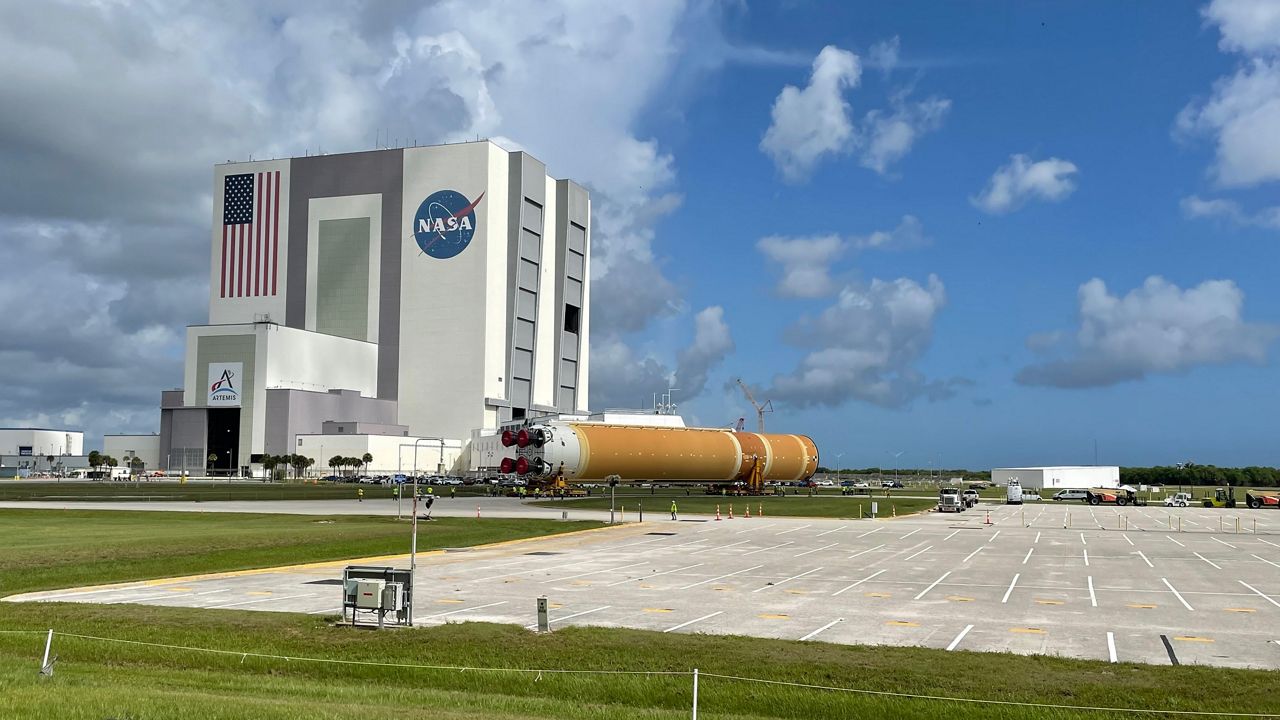CAPE CANAVERAL SPACE FORCE STATION — The Artemis II rocket’s core stage that will help carry four astronauts to orbit the moon — the first time in more than 50 years humans visited Earth’s lunar sister — arrived at NASA’s Kennedy Space Center on Tuesday.
What You Need To Know
- The 212-foot-tall core stage took about a 900-mile ferry ride from NASA’s Michoud Assembly Facility
- Learning about the Space Launch System rocket
- Understanding the Artemis missions
- Get more space coverage here ▶
- 🔻Scroll down to watch the core stage's journey to the Vehicle Assembly Building🔻
The fully assembled 212-foot-tall Space Launch System (SLS) rocket took about a 900-mile ferry ride from NASA’s Michoud Assembly Facility in New Orleans (where it was built) via the Pegasus barge on Tuesday, July 16.
The Artemis II core stage has been offloaded from NASA's Pegasus barge and transported into the Vehicle Assembly Building.
— Jon Shaban 🏪📺🎥🎤 (@Jon_Shaban) July 24, 2024
Full Story https://t.co/kUt2ViNQvl#NASA #SLS #ArtemisII #CoreStage@MyNews13 @AnthonyLeone @GPallone13 pic.twitter.com/Kr5lrNBXKN
On Wednesday, the rocket core stage was removed from the barge and moved into Kennedy Space Center’s Vehicle Assembly Building, a more than three-hour trek just to go a little less than half a mile.
At some point, while the core stage is all nestled in the Vehicle Assembly Building and being reviewed by engineers, the two solid rocket boosters and the Orion spacecraft will be attached to the massive rocket.
Matt Ramsey, Artemis II mission manager, said it was “shocking” and “fantastic” to witness the core stage being pulled out of the barge. He shared with Spectrum News the gambit the core stage will go through while it is in the Vehicle Assembly Building.
Matt Ramsey, #ArtemisII mission manager, gave me a brief explanation of what happens once the Artemis core stage is in the Vehicle Assembly Building.
— 🚀Anthony Leone🌕 (@AnthonyLeone) July 24, 2024
Learn more in my article at @MyNews13: https://t.co/wQ5k9Aqasy pic.twitter.com/nA9nAIwyks
The Artemis II mission is scheduled to take off in September 2025, sending a crew of four people to orbit the moon.
It was originally set to launch later this year, but in January 2024, NASA officials announced that the mission would be pushed back because of safety reasons, such as an issue with the heat shield.
Learning about the Space Launch System rocket
This rocket is currently the most powerful one on the planet and it is designed with the current moon mission in mind.
And according to NASA, it has everything it needs to send astronauts to the moon.
“At 212 feet tall, it consists of five major elements, including two huge propellant tanks that collectively hold more than 733,000 gallons of super-chilled liquid propellant to feed four RS-25 engines. During launch and flight, the stage will operate for just over eight minutes, producing more than 2 million pounds of thrust to propel four astronauts inside NASA’s Orion spacecraft toward the moon,” NASA stated.
Unlike SpaceX rockets, neither the SLS core stage nor its twin solid rocket boosters are reusable.
The contractors for the SLS are:
- Boeing: The core stage
- L3 Harris Technologies’ company Aerojet Rocketdyne: The four RS-25 engines
The twin solid rocket boosters, one on each side of the orange-colored core stage, help thrust the bulk of the SLS rocket and the Orion spacecraft off the launch pad.
NASA's Space Launch System Manager John Honeycutt said Wednesday was a great day and a big accomplishment for the Artemis team. He said the rocket core represents a lot of hard work from the various teams who helped build it.
He shared about how he was pleased with the performance of the SLS rocket in the first Artemis mission and told Spectrum News about the changes were applied to the core stage for the Artemis II mission.
John Honeycutt, the #SpaceLaunchSystem manager for @NASA’s #ArtemisII mission, talked about the lessons learned from #ArtemisI and how they were applied to the core stage for Artemis II.
— 🚀Anthony Leone🌕 (@AnthonyLeone) July 24, 2024
Learn more about the core stage in @MyNews13 story here: https://t.co/wQ5k9AqIi6 pic.twitter.com/BvvMRvxWCT
Understanding the Artemis missions
The Artemis missions have some simple objectives, according to NASA.
"With Artemis missions, NASA will land the first woman and first person of color on the moon, using innovative technologies to explore more of the lunar surface than ever before," the space agency stated.
The first three Artemis missions — broken down as Artemis I, Artemis II and Artemis III — are designed to return humans to the moon.
The Artemis I was an uncrewed test flight in 2022 that gathered information that NASA will utilize for the two later missions.
Artemis II mission will see NASA astronauts Reid Wiseman, Christina Koch, and Victor Glover and Canadian Space Agency astronaut Jeremy Hansen orbit the moon.
During the first launch attempt of Boeing’s Starliner maiden crewed flight in May 2024, Hansen shared his thoughts about going up into space for the first time during the Artemis II mission.
#ArtemisII Mission Specialist Jeremy Hansen was telling me what makes @BoeingSpace’s #Starliner mission special and his thoughts of going to space for the first time and not just the first time but also orbiting the #moon.
— 🚀Anthony Leone🌕 (@AnthonyLeone) May 7, 2024
Find out more @MyNews13 https://t.co/NgEcqfLybZ pic.twitter.com/wzejVsGP9K
And Artemis III will see the first woman and person of color to step foot on the lunar surface. They have not been named as of yet.
That mission is currently set for September 2026.



